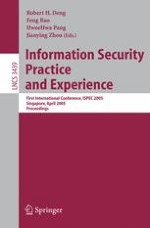The inaugural Information Security Practice and Experience Conference (ISPEC) was held on April 11–14, 2005, in Singapore. As applications of information security technologies become pervasive, - sues pertaining to their deployment and operation are becoming increasingly important. ISPEC is intended to be an annual conference that brings together researchers and practitioners to provide a con?uence of new information se- rity technologies, their applications and their integration with IT systems in various vertical sectors. The Program Committee consisted of leading experts in the areas of information security, information systems, and domain experts in applications of IT in vertical business segments. The topics of the conference covered security applications and case studies, access control, network security, data security, secure architectures, and cryp- graphic techniques. Emphasis was placed on the application of security research to meet practical user requirements, both in the paper selection process and in the invited speeches. Acceptance into the conference proceedings was very competitive. The Call for Papers attracted more than 120 submissions, out of which the Program Committee selected only 35 papers for inclusion in the proceedings. Thisconferencewasmadepossibleonlythroughthecontributionsfrommany individuals and organizations. We would like to thank all the authors who s- mitted papers. We also gratefully acknowledge the members of the Program Committee and the external reviewers, for the time and e?ort they put into reviewing the submissions. Special thanks are due to Ying Qiu for managing the website for paper s- mission,reviewandnoti?cation.PatriciaLohwaskindenoughtoarrangeforthe conference venue, and took care of the administration in running the conference.
